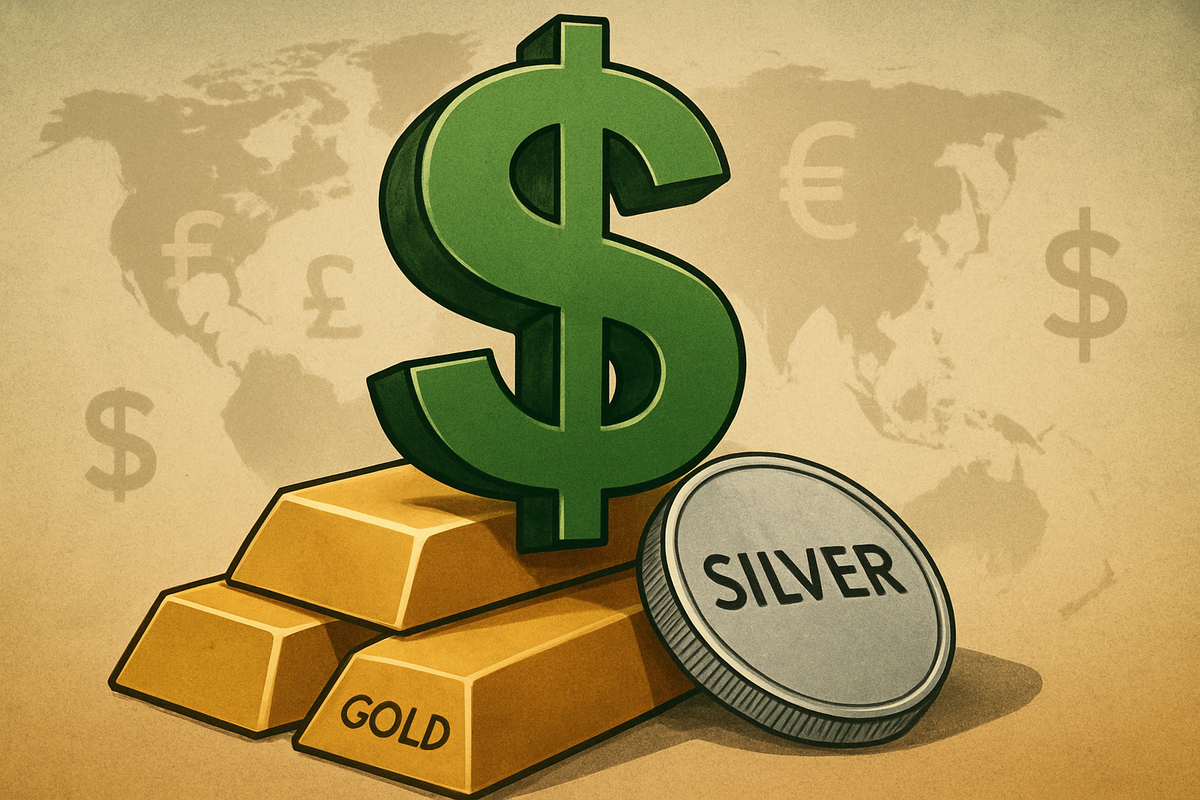
November 17, 2025 – The financial markets are once again grappling with the formidable strength of the US Dollar, a force that is exerting considerable pressure on the prices of gold and silver and reshaping the calculus for international buyers. As of mid-November 2025, the US Dollar Index (DXY) is showing renewed vigor, driven by hawkish signals from the Federal Reserve and the anticipation of crucial economic data. This resurgence makes dollar-denominated commodities, including the venerable precious metals, significantly more expensive for those holding other currencies, consequently dampening global demand and creating ripples across commodity markets worldwide.
While the dollar's recent strengthening has put a squeeze on gold and silver, the broader context reveals a complex interplay. The DXY, currently hovering around 99.0-99.5, reflects a rebound from earlier lows in the year but also a struggle to decisively break above the psychologically important 100 level. This dynamic environment means that while immediate pressures are evident, the long-term outlook for precious metals continues to be influenced by a myriad of factors, including persistent central bank demand and geopolitical uncertainties.
The Intricate Dance: Currency Strength and Precious Metal Valuations
The relationship between the US Dollar and precious metals like gold and silver is a fundamental dynamic in global finance, typically characterized by an inverse correlation. When the dollar strengthens, it generally makes dollar-denominated assets more costly for international investors using other currencies, thereby reducing their purchasing power and often leading to a decline in demand and prices for commodities such as gold and silver. Conversely, a weaker dollar makes these metals more attractive and affordable, often pushing their prices higher. As of November 17, 2025, this classic dynamic is playing out with renewed intensity.
The current strengthening of the US Dollar, marked by a 0.97% gain over the past month, comes despite a broader depreciation of 6.29% over the last 12 months. This recent bullish turn is largely attributable to the Federal Reserve's "higher-for-longer" interest rate outlook. Recent hawkish statements from Fed officials have significantly tempered market expectations for a December interest rate cut, with probabilities dropping from earlier estimates of 63-88% to approximately 40-51%. This stance makes interest-bearing US assets more appealing compared to non-yielding alternatives like gold and silver, drawing capital away from precious metals. Furthermore, the market is keenly awaiting delayed US economic reports, particularly the nonfarm payrolls, which will provide critical insights into the health of the US economy and further inform the Fed's future policy decisions.
Gold prices, which had seen robust momentum earlier in November, surging above $4,240, have experienced declines in domestic futures markets following the dollar's appreciation and the Fed's hawkish tone. Despite sharp selling pressure, gold has largely managed to hold support above the $4,000 threshold, indicating underlying resilience. Silver, too, witnessed significant volatility, staging a strong rally earlier in the month and even retesting all-time highs, propelled by expectations of rate cuts and increasing industrial demand, particularly from the burgeoning artificial intelligence sector. However, like gold, it faced substantial price declines after the Fed's recent comments. Key players in this scenario include central banks, which continue their consistent accumulation of gold as a diversification strategy away from dollar-denominated assets, providing a structural floor for prices. Additionally, large institutional investors and commodity traders are constantly adjusting their positions based on these currency and interest rate dynamics. The recent resolution of the US government shutdown has also played a role, reducing immediate safe-haven demand that might have otherwise supported both the dollar and precious metals.
Corporate Fortunes: Winners and Losers in a Strong Dollar Environment
A robust US Dollar creates a distinct set of winners and losers within the corporate landscape, particularly for companies involved in mining, refining, and trading precious metals, as well as those with significant international operations. The direct impact on commodity prices translates quickly into financial results, influencing revenue, profit margins, and investment decisions.
Mining companies, such as Barrick Gold Corp. (NYSE: GOLD) and Newmont Corporation (NYSE: NEM), which extract gold and silver, typically face headwinds when the dollar strengthens. While their operational costs are often incurred in local currencies, their revenue is tied to dollar-denominated metal prices. A stronger dollar means that the converted value of their sales, when reported in their home currencies (if not USD), might be lower, or more directly, the lower dollar price of the metals reduces their top-line revenue. This can squeeze profit margins, especially for high-cost producers. Conversely, companies with significant debt denominated in other currencies might see their debt burden effectively reduced when converted to a stronger dollar, though this is often a minor benefit compared to revenue impacts.
On the other hand, companies that are primarily buyers or consumers of gold and silver for industrial or manufacturing purposes, particularly those based outside the US, might experience increased input costs. For international jewelry retailers or electronics manufacturers, a strong dollar makes their raw materials more expensive, potentially forcing them to absorb costs, reduce margins, or pass price increases to consumers, which could dampen demand. However, US-based companies that import goods priced in weaker foreign currencies might benefit from reduced import costs. For example, a US-based refiner like Johnson Matthey PLC (LSE: JMAT), which processes precious metals, might see a mixed impact depending on its global sourcing and sales strategies. Commodity trading firms, such as Glencore PLC (LSE: GLEN), with sophisticated hedging strategies and diverse portfolios, are better positioned to navigate currency fluctuations, potentially profiting from volatility through arbitrage or strategic positioning. Ultimately, the immediate impact of a strong dollar tends to favor dollar-denominated assets and disadvantage non-dollar investors in precious metals, forcing companies to meticulously manage currency risk and operational efficiency.
Broader Implications: A Shifting Global Economic Compass
The current strength of the US Dollar and its repercussions on gold and silver prices extend far beyond the immediate financial markets, signaling broader industry trends and potential ripple effects across the global economy. This event fits squarely into the ongoing narrative of central bank monetary policy divergence and the continued search for safe-haven assets amidst geopolitical uncertainties.
The "higher-for-longer" interest rate stance from the Federal Reserve, which underpins the dollar's recent rally, highlights a broader trend of central banks prioritizing inflation control, even at the risk of slower economic growth. This contrasts with some other major economies, where central banks might be signaling a more dovish stance, leading to a widening interest rate differential that attracts capital to the US. This capital flow can strain emerging markets, making it more expensive for them to service dollar-denominated debt and potentially exacerbating economic vulnerabilities. The ripple effects are felt by competitors and partners alike; for instance, gold-producing nations, whose economies are heavily reliant on precious metal exports, could see reduced foreign exchange earnings. Regulatory bodies are also closely monitoring these currency movements, as extreme volatility could necessitate interventions or policy adjustments to maintain financial stability. Historically, periods of strong dollar appreciation have often coincided with global economic slowdowns or crises, as seen during the Asian Financial Crisis or the European sovereign debt crisis, where the dollar acted as a primary safe haven. While the current situation isn't as dire, it draws parallels in terms of capital flight towards dollar assets. The persistent accumulation of gold by global central banks—a trend that has accelerated in recent years—underscores a strategic move to diversify reserves away from an over-reliance on the dollar, indicating a long-term shift in the global financial architecture. This trend suggests that while the dollar may exert short-term dominance, nations are actively hedging against its long-term volatility or potential future depreciation.
What Comes Next: Navigating the Tides of Currency and Commodities
Looking ahead, the trajectory of the US Dollar and its consequent impact on gold and silver prices will be shaped by a confluence of monetary policy decisions, economic data, and geopolitical developments. In the short term, market participants will be keenly focused on upcoming US economic reports, particularly the nonfarm payrolls and inflation data. Stronger-than-expected data could further solidify the Fed's hawkish stance, providing additional impetus to the dollar and maintaining downward pressure on precious metals. Conversely, weaker data could reignite expectations of earlier rate cuts, potentially weakening the dollar and offering a reprieve for gold and silver.
In the long term, the strategic pivots required for investors and companies will revolve around robust risk management and diversification. Precious metal miners may need to enhance operational efficiencies and explore hedging strategies to mitigate currency and price volatility. International buyers will continue to seek alternative sourcing or explore forward contracts to lock in prices. Market opportunities may emerge for astute investors who can identify undervalued assets in the precious metals sector during periods of dollar strength, anticipating a future reversal. Conversely, challenges will persist for those heavily exposed to dollar-denominated costs or revenues without adequate currency hedges. Potential scenarios include a sustained dollar rally if global economic growth falters outside the US, leading to prolonged pressure on gold and silver. Alternatively, a significant shift in the Fed's policy, perhaps due to an unexpected economic downturn, could trigger a dollar depreciation, providing a strong tailwind for precious metals. The ongoing geopolitical tensions and the continued de-dollarization efforts by some nations through gold accumulation suggest that while short-term volatility is likely, the fundamental demand for precious metals as a store of value and a hedge against uncertainty remains robust.
Comprehensive Wrap-Up: Enduring Significance and Investor Watchpoints
The current narrative of a firm US Dollar impacting gold and silver prices is a critical event that underscores the intricate and often counterintuitive dynamics within global financial markets. The key takeaway is the powerful influence of central bank monetary policy, specifically the Federal Reserve's "higher-for-longer" interest rate outlook, which has revitalized the dollar and, in turn, made dollar-denominated commodities less attractive for international buyers. This has led to immediate downward pressure on gold and silver prices, despite their earlier rallies driven by different market expectations.
Moving forward, the market will remain highly sensitive to economic data releases and any shifts in central bank rhetoric. Investors should assess their portfolios for exposure to currency risk and consider how a sustained strong dollar environment might affect their holdings. For those interested in precious metals, the current environment presents a nuanced picture: while short-term pressures exist, the long-term structural demand from central banks and the inherent safe-haven appeal of gold and silver against geopolitical uncertainties continue to provide foundational support. What investors should watch for in the coming months includes the trajectory of inflation, the timing and pace of any potential Fed rate adjustments, and the evolving geopolitical landscape. These factors will be instrumental in determining whether the dollar maintains its iron grip or if precious metals can once again assert their traditional role as a hedge against currency fluctuations and economic instability. The enduring significance of this event lies in its demonstration of how intertwined currency markets are with commodity valuations, and how central bank actions can send powerful ripple effects across the global financial system.
This content is intended for informational purposes only and is not financial advice







